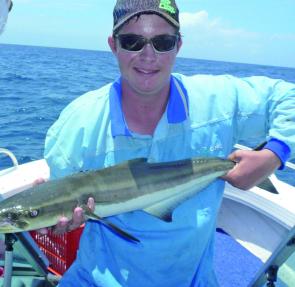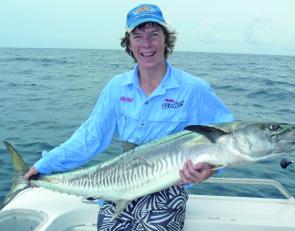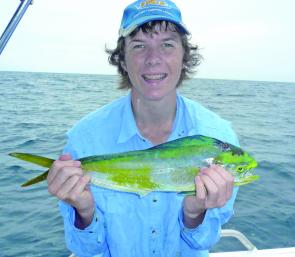Here is the second part of the series on how and where to catch pelagics in the Bundy region. Even though these tips are designed for Bundaberg fishing, they can be used in whichever area you are fishing.
With summer in full swing the pelagics are everywhere at present! Tuna are busting the surface, mackerel are sitting below them eating the scraps and the cobia and reef fish are having a ball on all the fresh bait that is going their way.
In this article I will be focusing on the hoards of mackerel that are on the move north.
When you are targeting these muscular fish there are certain types of spots to focus on. These include big bommies, most ship wrecks, reefs and also shoals. Mackerel choose these areas as bait tend to congregate in these sites.
If you can’t find any fish sitting over these areas, look for birds diving. This can indicate tuna feeding, which usually means the mackerel will be sitting underneath looking for an easy feed. Wearing polarised sunnies is a good way to protect your eyes from the sun and also to see these fish feeding.
At the start of the season you will generally get the smaller species of mackerel, such as schoolies, spotties and greys. These smaller fish hang fairly close inshore and are an easy target for people fishing from smaller boats. The Spanish mackerel move into our area around late November early December, which is when the real fun starts.
When the mackerel are down deep there are three major methods that can be used to fool them. The first is trolling deep diving lures over the top of the structure. The second is casting metal slugs and letting them drop to the bottom then retrieving them nice and fast. And the third is putting a live bait out underneath a balloon.
When they are feeding on the surface, trolling skirts and casting metal slugs at them are both sure ways of catching them. As with tuna, mackerel will feed into the wind as it creates an extra barrier for the baitfish; this is one way of trying to figure out which direction they are moving in.
During the summer months I have had some really fun trips out chasing pelagics. A recent trip out to a local wreck turned from being a bad trip with strong winds to an awesome trip with some very memorable catches.
The seas were at about 1.7-2m and we had to do about 9 knots the whole way out. We chased a couple of tuna schools on the way and Mum picked up a small striped tuna. This fish got us excited as they go so hard and aren’t very common in the Bundy region.
From this point we had about 2 miles to go until we reached the wreck, and by this stage it was 8.30am and the wind had started to ease off. Once at the spot we started trolling skirts around the mass of birds that had congregated there and straight away picked up three Spaniards. They then went off the skirts and started hitting hardbodies. With seven Spanish in the boat it was decided to do some high speed jigging.
Jigging proved to be a good move as my mate picked up an 18kg GT on 10lb braid – to say he was excited is an understatement! To top this trip off there was Cobia sitting underneath the abundant bait balls and we caught seven of them for the day, this was my mates first Cobia as well. So when the bait moves in to Bundy the fish go crazy all summer long!
If you are going to take Mackerel home they are a good table fish and will also fill the esky quite fast if you get on to a patch of them. But make sure you bleed the fish first otherwise they don’t taste as good. Remember to check the size and bag limits in your area before you go out otherwise you could risk a big fine from the Fishery officers.
Tackle to stop these toothy fish needs to be fairly heavy. If you are chasing the smaller species of 6kg and under a spin reel around the 4000-5000 size and a rod with a rating of 6-10kg loaded with 20lb monofilament or braided line will be fine. A wire trace is a must as these fish will bite through monofilament leaders with ease.
If it’s trolling that you prefer, use something like a TLD 15 on a 6-10kg rod with 6-15kg mono or braid. When the Spaniards come in you will want to beef up the gear you are using. I use a Tyrnos 20 on a Backbone elite but something like a TLD 20-25 will be fine. On Spaniards you can use anything between 15kg mono right up to 80lb braid.
If you are going to jig or cast for these bigger fish a reel around 6000-8000 in size and a 10-15kg rod will be just right. If trolling or slug chucking doesn’t take your fancy there are other options.
The first is live baiting. Once you have anchored on the patch of ground, chuck some bait jigs down to get a few yakka. Put a 8/0 hook on the end of your line and a balloon approximately 20ft up your line. Feed the hook through the back of the yakka and let him swim around 30-50ft out the back of your boat.
Using this method when fishing for reef fish can yield surprising results. This technique can catch mackerel and cobia and it has been known to catch some decent sized reef fish when fishing shallow ground.
Mackerel can also bet targeted on fly gear. Once you have mastered this style of fishing it is loads of fun and can be a lot more exciting than the other methods. When chasing these fish a 10 weight fly rod with 10 weight intermediate line should do the trick on the smaller fish of around the 8kg and under mark. But if you are chasing the bigger fish a 12 weight rod and line is more suitable.
Some lures can be used when casting and jigging to all species of mackerel. These include the Gillies Whitebait in 25-40g, the Surecatch Surejig Pilchard 42-c, and various other metal lures. But remember before you use any metal lure be sure to change the trebles and split rings on them because I have found that the stock standard hooks and rings just don’t handle the pressure of any of the pelagic species.
When trolling for these toothy critters, lures like the Rapala X-Raps, CD-18s Halco Laser Pros, and also skirted lures such as the Tropic Angler in Lumo and Electric Blue colours will generally catch fish.
Flies I use for these fish are mainly Surf Candies and Clousers but I’ll say it again, make sure with all of these rigs that you use a wire trace!
Next time you are going offshore, before you go chasing reef fish have a troll around some of the local reefs and bommies to catch some tasty mackerel for the table and also have some fun doing so!
Reads: 12015
Sam Gatt recently caught his first black king offshore.

These birds spotted a bait ball, which was being terrorised by some massive pelagics. Birds are great signposts for locating fish.

Elle Hodge with a Spanish caught on a skirt – skirted lures will usually prove successful.

The author with a Spanish mackerel caught on a Tropic Angler skirt in Electric Purple

This baby mahi mahi was a by catch of trolling skirts for Spaniards.

Sam Gatt with his giant trevally. GT often haunt the same grounds as big Spaniards and other monsters.




